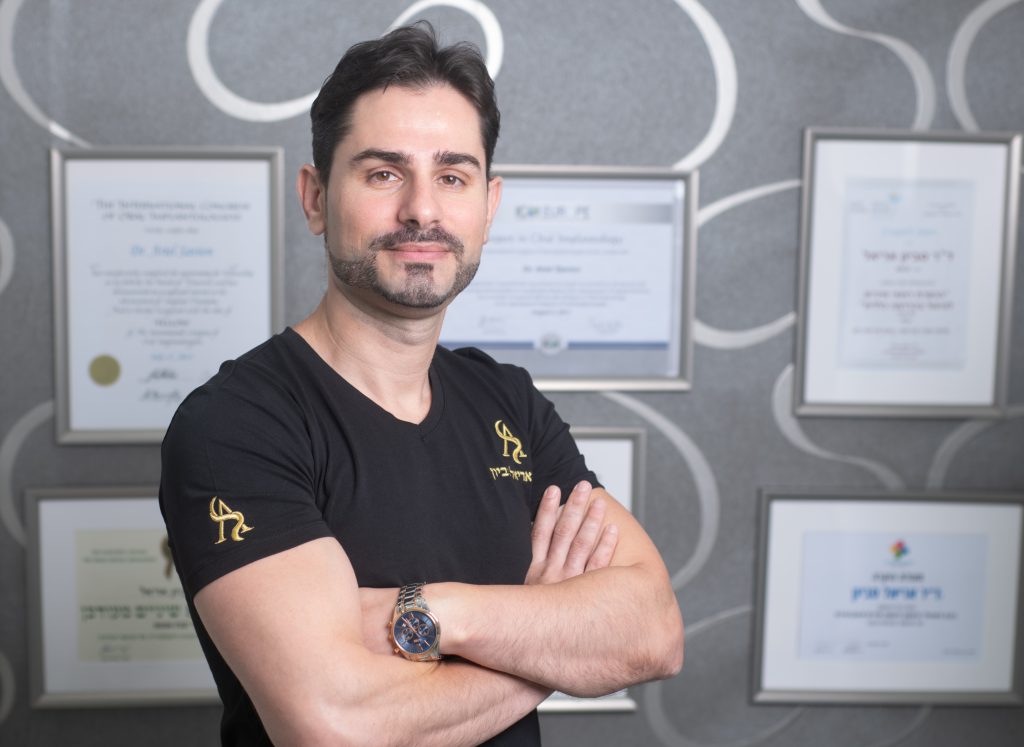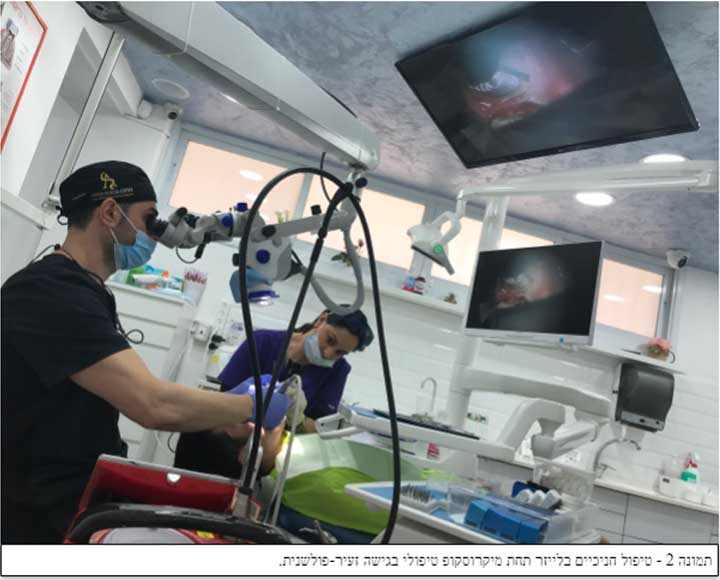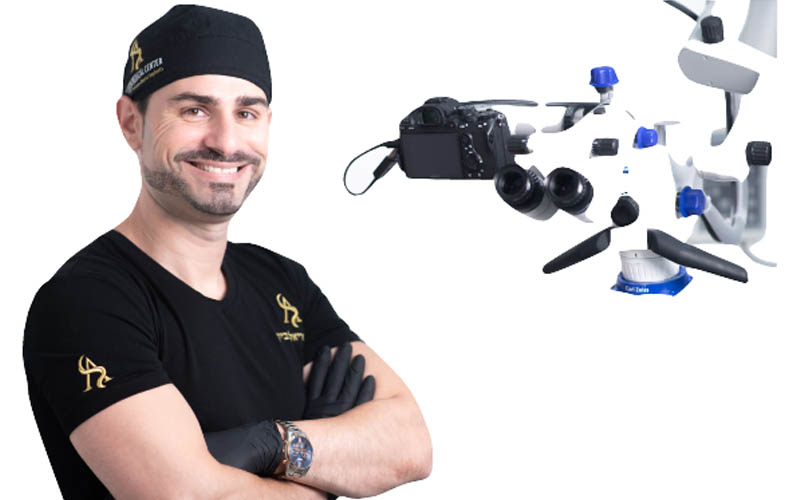Laser Technology in Dental Care
In contemporary dentistry, the gold standard is minimally invasive treatment that preserves natural teeth, maintains gum health, and prevents unnecessary over-treatment.
Minimally invasive dentistry is both effective and comfortable for patients while preserving healthy teeth. Dental lasers are designed precisely for this noble purpose. Laser technology enables conservative dental treatment, saving patients valuable time and significant costs.
Dr. Ariel Savyon
Dentist since 2007, holds a double master's degree (Germany) in laser science and implantology (dental implants).
Serves as medical director of the dental corporation "Savyon Medical Center Ltd. Owner of a prestigious study club master_implant, treating dentists in various fields. The only certified instructor in Israel of the World Clinical Laser Institute in the field of laser science in dentistry in Israel.
Dr. Savyon, an opinion leader for leading companies in Israel and around the world, a researcher and international lecturer in the field of laser dentistry, periodontal medicine, and dental implants.

table of contents
About Laser Technology
LASER (Light Amplification by Stimulated Emission of Radiation) is a device that emits concentrated, focused light (unlike a flashlight with dispersed light). The light is amplified through an electrical power source and photon emission, producing non ionizing radiation (causing no health damage).
Laser energy is monochromatic (single color wavelength), coherent, and highly useful across many fields. However, lasers can be dangerous to eyesight, so proper safety protocols must be carefully reviewed before use.
Laser technology is one of the fastest developing fields in the modern world. In essence, a laser can be defined as an energy conversion device, with output always in electromagnetic form, including light rays. The light amplification process occurring in a laser device is called "lasing." In medicine, various lasers exist with different characteristics.
Dentistry Common Laser
Some of the Common Laser:
- Diode Lasers – Located in the near-infrared spectrum with wavelengths ranging from 800-1100 nanometers. Diode lasers in dentistry are used exclusively for soft tissue treatment and cutting, not for hard tissue (bone, tooth crown, root, cementum, implants). An additional use is cold laser therapy (LLLT), which accelerates healing and relieves pain by introducing energy to tissues and cells, creating ATP energy. Diode lasers are well absorbed by melanin and hemoglobin, the same principle used in laser hair removal due to light energy penetration depth and absorption in hair pigment.
- Erbium Lasers – Located in the mid-infrared spectrum with wavelengths ranging from 2700-3000 nanometers. Erbium lasers are designed for both soft and hard tissue treatment (bone, teeth, cavities, gums, roots).
- Gas Lasers (CO2) – Located in the far-infrared spectrum with wavelengths ranging from 9300-10000 nanometers. Well absorbed by water and hydroxyapatite (enamel), these lasers treat both hard and soft tissues.

Laser Treatment Applications in Dentistry
Using lasers with different wavelengths, dentists can perform a wide range of surgical and non surgical procedures from cavity removal to treating infected root canals. Lasers effectively treat chronic gum diseases and perform apicoectomies for periapical inflammation, preserving teeth for many years
Surgical Procedures Include:
- Laser-assisted dental implant placement
- Tissue harvesting for gum grafts
- Exposing impacted teeth
- Crown lengthening for
Lasers also provide pain relief, treat cold sores and canker sores, achieve hemostasis while avoiding sutures, clean inflammatory tissue during extractions or implant procedures, treat peri-implantitis, perform flapless implant exposure, and much more.
Laser Dentistry – The Future of Gentle & Precise Dental Care:
Advantages of Laser Dental Treatment
Important advantages:
- Precision – Dental lasers are extremely accurate, allowing dentists to focus on specific oral areas with minimal damage to surrounding tissues, leading to better treatment outcomes and faster healing
- Minimally Invasive – Laser procedures are considered microsurgical as they typically require no incisions or sutures, causing less post-operative pain and discomfort.
- Reduced Bleeding – Lasers cauterize tissue while cutting, significantly reducing bleeding and making procedures more comfortable.
- Lower Infection Risk – Dental lasers kill bacteria and sterilize treatment areas, reducing infection risk and promoting faster healing.
- Faster Recovery – Laser treatments cause less trauma to surrounding tissues, contributing to quicker recovery times and earlier return to normal activities.
- Reduced Anesthesia – In some cases, laser procedures require no anesthesia, reducing risks associated with sedation or general anesthesia.
- Patient Comfort – Many patients report significantly greater comfort during and after laser treatments, as they are less painful and cause less anxiety than traditional dental tools and procedures.
- Customized Treatment – Dental lasers offer various customizable treatment options, allowing dentists to tailor treatments to each patient's unique condition, needs, and preferences.
Laser Assisted Dental Implants
Laser energy use in dental implants leading microsurgical treatment to the forefront of technology. Laser-assisted dental implantation, combined with a therapeutic microscope, is defined as minimally invasive surgical treatment that accelerates post-implantation healing with less pain and swelling, compared to invasive treatment with numerous complications and risks including prolonged recovery, pain, hematoma, infection risk, and antibiotic requirements, especially for systemically compromised patients.
| Symptoms | Laser Integration Benefits |
| Bleeding | Bleeding control, cauterization of damaged blood vessels |
| Disinfection | Sterilization and vaporization of gingival pockets or contaminated areas during extractions and surgical treatment during implantation |
| Pain | Patients treated with lasers during and after surgical procedures are pleasantly surprised to find that surgery doesn't require suffering, pain, or disruption to normal life |
| Dental Phobia and Anxiety | Addresses dental anxiety effectively |
| Systemically Compromised Patients and Smokers | Enables flapless implant placement without sutures, avoiding healing interference, infections, failures, and uncontrolled bleeding |
- Bleeding Control – Lasers control bleeding and cauterize damaged blood vessels. Complete bleeding control during surgical treatment increases success rates and reduces complications, risks, and failures.
- Disinfection – Lasers enable sterilization and vaporization of gingival pockets or contaminated areas during extractions and surgical treatment during implantation. The goal is to vaporize and eliminate anaerobic bacteria (oxygen-averse bacteria) found in bone tubules, periodontal pockets, and soft tissue.
- Laser use during surgical treatment shortens implantation time, reduces pain levels, enables single-session surgery, decreases pain and swelling, accelerates healing, and reduces infection or failure probability.
- Pain Management – The laser plume and light energy prevent smear layer formation, don't heat bone, cause no vibrations or trauma in the treatment area, and create bio stimulation that accelerates healing. Patients treated with lasers during and after surgery are pleasantly surprised that surgical treatment doesn't require suffering, pain, or life disruption. In most cases, patients don't receive antibiotic or steroid prescriptions. For pain relief, cold laser treatment can be used by introducing cellular energy and increasing ATP production, dramatically accelerating healing and reducing swelling. Light energy use advocates a biological concept for natural body healing.
- Dental Phobia and Anxiety – Lasers enable atraumatic treatment soothing, pain-free surgery with significantly reduced anesthesia use, creating a friendly, encouraging environment that dramatically reduces dental anxiety levels.
- Systemically Compromised Patients and Smokers – Lasers enable flapless implant placement without sutures, avoiding healing interference, infections, failures, and uncontrolled bleeding. Microsurgical approaches under therapeutic microscopes combined with light energy make implantation easier and simpler even for high-risk patients with systemic diseases.

Laser Crown Lengthening
Clinical crown lengthening (extending the visible tooth portion) is a common procedure in periodontal treatment. A recent American Academy of Periodontology survey found approximately 10% of all periodontal surgeries performed were crown lengthening procedures.
The surgical procedure requires proper preparation and complete evaluation by the dentist of oral and jaw structure. Laser gum contouring is predictable, painless, prevents suturing, enables quick return to routine, is simple and fast, with no side effects or complications.
Lasers are stable and vibration-free, their use is completely sterile requiring no disinfection between patients and no infection risk, bleeding risk is significantly smaller compared to powered instruments and scalpels.
Laser Gum Contouring
Gum contouring is performed using lasers along angular gingival lines adjacent to teeth and their intersection at the interdental papillae. This reshapes the patient's gingival borders.
The primary advantage of laser gum contouring is sharp, focused cutting without bleeding.
Initial incision placement follows existing keratin tissue layer depth. For patients with insufficient keratin tissue, the initial incision distance from gingival margins matches keratin layers in adjacent teeth.

Chronic Gum Disease Treatment
Minimally invasive gum disease treatment is comfortable and effective while preserving healthy tissues. Recent evidence shows laser gum disease treatment has potential to improve therapeutic outcomes and preserve teeth from extraction. Therefore, lasers prove highly useful in root planing and chronic gum disease treatment without flap elevation or sutures.
Gum Disease and Laser Treatment Advantages
Laser has antimicrobial effect (replacing antibiotic needs) and cellular bio stimulation for periodontal regeneration without scalpels, using minimally invasive approaches.
Common lasers for gum disease treatment include diode lasers (800-1100nm) and erbium lasers (2780-2940nm). Laser wavelength determines absorption and penetration depth of laser energy in tissue.
Treatment Protocol
First, in preliminary gum treatment, we use diode lasers designed exclusively for soft tissue treatment. Diode lasers are well absorbed by melanin and hemoglobin and pass through water (not absorbed by water).
The laser vaporizes bacteria in gingival pocket areas through energy absorption in bacterial pigment (black pigment). The laser tip isn't activated (doesn't cut) but only introduces energy to pocket depth for disinfection and bacterial vaporization.
Laser treatment occurs before calculus removal or root planning without local anesthesia. Subsequently, the laser tip can be activated to remove inflammatory tissue at pocket depth and create hemostasis.
Laser vs. Conventional Gum Disease Treatment Advantages
- Easier, more convenient treatment requiring no special preparation, usually saving chair time
- Minimally invasive approach without incisions or sutures with faster recovery
- More effective treatment as laser energy penetrates bone depth and kills bacteria
- Lasers can be used for pain relief with quick return to routine
- Laser energy doesn't damage tooth cementum unlike conventional treatment (root scaling)
Laser Gum Treatment and Emdogain Regeneration
- The method particularly suits anxious patients with dental phobia
- No contraindications for systemically compromised patients (diabetes, hypertension, heart conditions)
- Advanced dentistry with superior results
- Post-operative pain barely noticeable
- Encourages patients to undergo additional necessary treatment
Today's trend is saving natural teeth and their supporting attachment system, preserving them as much as possible. Gone are the days when dentists rushed to perform extractions followed by dental implants.
There's no true replacement for natural teeth due to their unique mechanism and periodontal ligament that implants lack. Today, tooth preservation success rates are higher, especially when using Enamel Matrix Derivative protein for periodontal regeneration based on natural protein responsible for tooth formation, Emdogain by Swiss company Straumann.
What is Emdogain?
Emdogain is a biologically active material containing proteins, essentially a family of proteins called Amelogenin or Enamel Matrix Derivative. Developed by a Swedish company and registered as a worldwide patent, the material encourages regeneration of hard and soft tissues (periodontal ligament and cementum) and is scientifically proven safe and effective.
Primary Emdogain use is regenerating supporting bone around teeth located within the jaw. Notably, Enamel Matrix Derivative proteins naturally occur on tooth surfaces during tooth eruption, playing crucial roles in creating tooth-to-bone connections.
The material is prepared in advanced Swiss laboratories, and dentists specializing in this treatment receive Emdogain in sterile syringes.
When to Consider Emdogain Treatment with Laser
Statistically, three out of four people will suffer from gum inflammation at some degree during their lives. Generally, Emdogain is used to enable gum and jawbone regeneration after acute gum inflammation. First, inflammatory tissue is vaporized using lasers while simultaneously sterilizing bone tubules and tissue through laser light energy.
Gum Inflammation Development
Gum inflammation is common in dentistry, developing gradually due to bacteria settling between teeth and gums. Without proper brushing and oral hygiene, bacteria rapidly develop in the area, known as dental plaque.
Without plaque removal and following prolonged neglect, chronic gum inflammation may occur, potentially causing loosened tooth attachment and tooth loss.
Diagnosing Gum Inflammation
Early detection is challenging as initial stages show few symptoms. Most patients visit dentists only when suffering familiar symptoms like gingival swelling, redness, bleeding, high sensitivity, and pain. Without treatment, gum inflammation worsens, causing additional damage like gum recession, jawbone damage, tooth spacing, loosening, and tooth loss.
Emdogain Treatment Process
Emdogain treatment rehabilitates soft and hard tissues by encouraging bone creation in bony defects and renewing periodontal ligaments damaged by bacterial toxins. Protein material naturally encourages tooth bone healing without external intervention.
The material is injected onto tooth roots using special tips inserted to pocket depth under microscope magnification. The material immediately begins working, helping regenerate tissues lost due to inflammation. Final results are visible after 12 months.
For material introduction, dentists use dental microscopes, minimally invasive treatment replacing resective approaches requiring surgery to eliminate pockets after cutting gums and exposing bone.
In minimally invasive approaches, root surfaces are exposed after removing inflammatory tissue and cleaning root infection, applying Emdogain layers and filling deficits with bone substitute as needed to prevent soft tissue collapse and enable proper tooth supporting tissue growth.
Emdogain encourages cementum and tooth attachment tissue formation, promoting periodontal ligament and alveolar bone tissue growth. The material mimics natural childhood tooth supporting tissue production processes.
Recently, researchers discovered that the material also encourages gingival cell growth, significantly accelerating soft tissue healing and substantially reducing gum recession.
Laser Treatment for Gingival Hyperpigmentation
Gingival hyperpigmentation is common among many patients, also known as "black gums." This is an aesthetic problem, especially for patients with excessive gingival displays during smiling. Gingival color is determined by several factors including blood vessel number and size, epithelial cell thickness, keratinized gingival amount (orange peel texture), and epithelial cell pigment.
What Causes Hyperpigmentation?
Gingival hyperpigmentation is caused by excess melanin in the basal layer and above in the epithelial layer. Melanin comprises melanocytes in the basal layer. Hyperpigmentation degree depends on melanocyte activity in gums.
Gingival hyperpigmentation is determined by skin color, ethnicity and smoking. Light skinned patients typically have no gingival hyperpigmentation. Dark skinned patients and smokers have higher probability.
Laser Gingival Hyperpigmentation Treatment Advantages
- Laser use for gingival hyperpigmentation treatment has proven highly effective and safe with high success rates without complication or infection risks
- Laser use and its unique mechanism surpass all other techniques, demonstrating very high patient satisfaction in hyperpigmentation removal
- Pain-free treatment
- No bleeding during or after procedures
- Fast gingival healing
- No infection or infection concerns, can be performed without local anesthesia or with minimal anesthesia
Side Effects
Post-treatment side effects include mild discomfort and feeling of abraded gums. Laser gum treatment is advanced dentistry with high success rates, providing excellent aesthetic results without suffering or unnecessary over-treatment.
However, it's important to verify your dentist has appropriate training and uses dedicated lasers with correct wavelengths; otherwise, the experience becomes unpleasant for both patient and dentist.
Post Hyperpigmentation Treatment Instructions
No antibiotic treatment needed, no pain relievers necessary, avoid hot, spicy, salty foods, avoid causing trauma or aggressive brushing.
Laser Root Canal Treatment
Root canal treatment success depends on root canal cleaning and disinfection ability. However, root canal anatomical complexity makes effective cleaning and disinfection difficult against bacterial invasion.
The biggest obstacle is cleaning dentinal tubules (very small tubes in canal sides up to 1000 microns deep). The smear layer remaining in dentinal tubules resulting from mechanical bur action represents the biggest obstacle to effective bacteria-free root canal cleaning, causing short or long-term root canal treatment failure.
The smear layer includes inorganic materials, organic materials including bacteria and root canal residues. Chemical irrigation solutions like sodium hypochlorite (Dakin's), 2% chlorhexidine, or 17% EDTA frequently serve as root canal irrigation during cleaning and shaping.
However, none of these irrigation solutions constitute ideal root canal irrigation material. The apical tip (final end) of root canals presents cleaning and irrigation challenges. Without cleaning the canal tip, periapical inflammation develops due to bacterial proliferation and root canal infection.
Notably, excessive root tip widening causes irrigation material leakage beyond root tips, causing swelling, pain, and even hospitalization (sodium hypochlorite). Moreover, this causes root material leakage beyond root tips.
These irrigation materials diffuse into dentinal tubules very slowly, largely depending on temperature and material concentration. On one hand, medical literature presents various techniques with different irrigation materials; on the other hand, opinions differ among various world experts, with controversy regarding techniques and irrigation, especially in infected canals.
One chemical irrigation material disadvantage is penetration to dentinal tubule depth up to 1000 microns. In infected canals and retreatments, despite good characteristics combining sodium hypochlorite and chlorhexidine for canal disinfection, practice still involves placing calcium hydroxide dressing in additional sessions, waiting two weeks to one month.
After this period is root canal sealing performed using accepted warm compaction methods. Until now, additional calcium hydroxide session effectiveness hasn't been proven for achieving better results in infected root canal disinfection.
How Laser Technology Enhances Root Canal Treatment
Laser technology has long served as a worthy alternative to conventional chemical irrigation materials like sodium hypochlorite (Dakin's) in root canal treatments. However, biophysical characteristics of different laser wavelengths are crucial for various treatment uses.
Not every laser suits every medical procedure. Therefore, laser wavelength is essential before using it in specific procedures. Dentinal canals contain large volumes of water molecules. Diode laser light energy isn't absorbed by water molecules and penetrates through them, therefore serving for root canal disinfection in dentinal tubules, causing bacterial disinfection and vaporization up to 1000 microns deep.
Disinfection occurs through laser energy absorption in bacterial membranes and their breakdown due to temperature sensitivity in very short time. Bacteria have membranes with dark pigmentation (like melanin), making diode lasers very effective in root canal bacterial sterilization.
Consequently, diode laser biophysical properties and tissue absorption serve for deep plume penetration into dentinal tubules for bacterial sterilization before root canal sealing. Root canal treatment combined with lasers increases endodontic treatment success and tooth survival in the oral cavity for many years.
Erbium lasers with 2780 nanometer wavelengths are well absorbed by water molecules and hydroxyapatite. Erbium laser integration in root canal treatment involves main canal cleaning and shaping during root canal procedures. Erbium laser energy penetration depth is very superficial (up to 25 microns deep).
Erbium lasers vaporize smear layers in root canals, leaving dentinal tubules open to receive deeper bactericidal effects than chemical materials like sodium hypochlorite (economical at low 5% concentration).
Since 1999, erbium lasers with 2780 nanometer wavelengths effectively remove smear layers and dentin debris during root canal shaping. Additionally, erbium lasers can perform bubbling effect (bubbles within root canals), creating thermodynamic pressure resulting from laser energy use with physiological water, causing material residue vaporization, thus creating mechanical action during canal shaping.
Moreover, laser energy is proven effective in sterilizing infected dentin. Lasers are safe regarding temperature use due to biophysical properties of water molecule absorption and come with cooling systems during laser energy radiation.
Laser Treatment for Patients with Gag Reflex
Gag reflex exists in everyone, but some patients suffer from the phenomenon excessively. Patients may easily vomit from seeing dental instruments, smells, past treatment trauma, "intrusion" sensation into the oral cavity, or dental anxiety, blocked airways, and more.
What is Gag Reflex?
Gag reflex is a common reflex causing throat constriction after soft palate contact, creating gagging sensation. Gag reflex plays important roles, preventing object penetration into throats not entering through swallowing, preventing choking situations, though some people can control gag reflex.
The oral cavity is very sensitive, and some patients visiting dentists may suffer from heightened gag reflex for various reasons, typically clinic odors, trauma from previous dental treatments, unpleasant sensation of medical instrument introduction to mouths, severe dental anxiety, etc.
Gag Reflex, Dental Treatment, and Dental Anxiety
In May 2014, a comprehensive study published in The Journal of the American Dental Association indicated direct connections between vomiting needs during dental clinic treatment and high dental anxiety levels.
Dentists address this phenomenon in various ways familiar, challenging phenomenon for doctors. Until laser dental treatment was introduced, doctors had to try various methods like hypnosis and laughing gas, and in certain situations, they recommended dental treatment under general anesthesia.
Until recently, dentists addressed patients suffering from heightened gag reflex using the following methods:
- Hypnosis – Hypnosis suits dental anxiety treatment and also helps with gag reflex situations during dental treatments. Israeli law permits only dentists with professional field training to use hypnosis techniques, requiring special Ministry of Health licenses.
- Sedation and Consciousness Medication – Oral sedation medications reduce dental anxiety and ease gagging phenomena prevalent among many patients. If doctors recommend intravenous sedation and consciousness medication, anesthesiologist presence is required.
- Laughing Gas – Laughing gas particularly suits treating children suffering from dental anxiety and heightened gag reflex. Gas contributes to muscle relaxation and reduces anxiety, serving as an effective means for reducing pain sensations during dental treatments.
In severe situations, dentists can recommend combined treatment including medications reducing gag reflex, palate anesthetic material application, and laughing gas use.
- Alternative Treatment – Alternative medicine offers several effective techniques for reducing dental anxiety and easing gag reflex during dental treatments. Common methods include Chinese acupuncture and acupuncture.
- General Anesthesia – General anesthesia technique is common in advanced dental clinics, especially departments performing oral and maxillofacial surgeries. General anesthesia treatment suits severe dental anxiety situations in children or adults, patients suffering from heightened gag reflex, and cases where patients wish to undergo complex, prolonged treatment in shortest time possible for example, one-day dental implants including extractions and full mouth rehabilitation.
How Laser Dental Treatments Help Patients with Gag Reflex
Laser energy eliminates gag reflex, enabling patients to undergo wide ranges of dental treatments without suffering or pain.
- Treatment is very simple, requiring no anesthesia
- Treatment lasts less than one minute and is very effective during dental treatments
- Gag reflex treatment uses diode lasers with 940 nanometer wavelengths in invisible light spectrum
Light energy is monochromatic, focused, and high-powered, therefore very dangerous to eyes (can cause blindness). Protective glasses must be worn before use. The lasing process prevents gag reflex phenomena during dental treatments, enabling doctors to perform treatments easily without patient suffering.
How Does It Work?
Diode laser light energy is well absorbed by melanin and hemoglobin, used only for soft tissue in dentistry. Introducing light energy to soft palate and pharyngeal areas neutralizes receptors causing gag reflex.
Light energy is absorbed in tissue due to this wavelength's penetration depth in the electromagnetic spectrum. Parameters for diode laser use in gag reflex are very low and don't cause temperature elevation in irradiated tissue (less than 50 degrees Celsius).
Additional diode laser uses include pain relief and biostimulation with biological cellular activity effects without thermal effects. Laser gag reflex treatment provides dual effects, on one hand, gag reflex treatment through receptor neutralization; on the other hand, bio stimulation (cellular activity) and pain relief as needed (cold laser treatment).
Laser Treatment for Gummy Smile
Causes of Gummy Smile:
- Skeletal Deformity (Vertical Maxillary Excess – VME) – Excess maxillary bone in vertical position.
- Delayed Eruption – Can be passive or active eruption.
- Patients with Attrition – Compensatory tooth eruption including bone and gums contributes to gummy smile.
- Lip Hypermobility – Exposing gums and bone with strong lip muscle pull, with lips rising very high during exposure. Common phenomenon in most patients with excessive gingival display.
- Patients with Passive Eruption – Delayed eruption as sole gummy smile cause (excessive gingival display). According to medical literature, crown lengthening surgery contributes to proper gum-to-lip ratios, reduces gingival display relative to teeth, contributes to harmony and dental aesthetics.
Treatment can be performed with various laser types as advanced treatment. Patients return to full routine with significant pain or discomfort reduction. Results are immediately visible on surgery day.
Lip Repositioning – Lip repositioning using lasers, surgery for lip repositioning aims to restrict levator labii superioris smile muscle and reduce gingival display.
Surgical technique is performed using erbium lasers, replacing conventional scalpel methods. The technique involves removing mucosal strip from buccal vestibule averaging 12mm banana-shaped using lasers.
Suturing performed with absorbable sutures. Lip mucosal tissue is fixed using sutures to mucogingival junction. By shortening buccal vestibulum, excessive upper lip elevation during smiling is prevented.
Lip repositioning surgery using various lasers significantly contributes to pain and morbidity reduction after treatment. Moreover, lasers replace scalpels and contribute to bio stimulation and better control. Bleeding control during procedures is possible, performing procedures more accurately without patient stress or concerns.
Complications and Side Effects
Post-surgery, upper lip "tension" sensations occur during smiling and speaking in the first week post-surgery at high frequency. Patients may feel discomfort in the first week including lip swelling. Eye area redness with mild hematoma is also possible.
No nerve injury risk or nerve damage. Surgery can be performed without concern; however, proper lip repositioning is important, otherwise surgery won't be effective.
Lip repositioning surgery is definitely an alternative for improving excessive display results; however, consider crown lengthening with lasers first in passive tooth eruption cases, then reassess. In lip repositioning surgery, performing it using various lasers is recommended for complete bleeding control and faster healing than scalpel use.
Wisdom Tooth Extraction with Laser
Wisdom tooth extraction is a dental procedure involving removal of one or more wisdom teeth, the last molars erupting in the mouth's rear. Wisdom tooth extraction needs arise if they're impacted, infected, causing pain, impacted, or crowding or damaging adjacent teeth.
Laser wisdom tooth extraction is a minimally invasive technique using dental lasers to remove teeth. Lasers create incisions in gingival tissue, then extract teeth precisely and controllably. Lasers also sterilize areas, reducing infection risk.
Laser wisdom tooth extraction offers several advantages compared to traditional extraction methods, including:
- Reduced Pain and Discomfort – Laser-assisted wisdom tooth extraction is less invasive and less traumatic to surrounding tissue.
- Reduced Bleeding – Lasers cauterize blood vessels while cutting, reducing bleeding during and after procedures.
- Shorter Healing Time – Lasers also stimulate new tissue growth, promoting faster healing.
- Reduced Infection Risk – Lasers help sterilize surgical areas, reducing infection risk.
Laser Radiation Effects on Biological Tissue
Laser radiation effects on biological tissue can be divided by effect type:
- Thermal Effects – Created by continuous radiation lasers. Laser energy is absorbed in biological tissue, raising local tissue temperature in irradiated areas. According to temperature, processes like vaporization, coagulation, etc., occur.
- Mechanical Effects – Occur primarily when short laser radiation pulses at high intensity impact tissue. High energy amounts impacting concentrated areas cause immediate tissue heating. Since heating occurs in periods shorter than tissue expansion time due to heating, tissue explosion occurs, creating "shock waves" tearing surrounding tissues.
- Chemical Effects – Used in photodynamic therapy (PDT) and cold/soft laser for pain relief.
Laser Dental Treatment - Frequently Asked Questions
Yes, dental laser use is generally considered safe for patients when performed by licensed dentists who received appropriate laser dentistry training. Dental lasers are designed to focus on specific oral areas and are very precise, minimizing surrounding tissue damage risk.
Additionally, many dental lasers are equipped with safety measures designed to prevent accidental laser beam exposure. Some lasers have sensors detecting when laser beams approach sensitive areas, automatically adjusting power levels to minimize injury risk.
As medical procedure, some risks are associated with dental laser use, such as tissue damage risk if lasers aren't used correctly. However, these risks are generally low when procedures are performed by skilled, experienced dentists following appropriate safety protocols.
Laser treatment is recommended for systemically compromised patients, especially diabetes patients with high blood pressure, people with heart conditions (mandatory consultation with treating physicians), and patients taking bisphosphonates. The approach is minimally invasive. For patients with systemic diseases, surgical treatment can be performed without flap elevation or sutures, contributing to fast recovery without unnecessary complications.
Training is mandatory before performing laser dental treatments. The oral cavity comprises different tissues, and incorrect laser use on different tissues causes more harm than benefit. Therefore, doctors must undergo professional training on using different lasers and understand laser operation and use for personal and patient benefit. Incorrect laser use endangers doctors and patients. Patients shud verify their treating doctor's laser training and laser types and different wavelength uses.
Non-surgical gum treatment refers to all actions performable to reduce inflammation and vaporize anaerobic bacteria causing active gum disease, achieving periodontal regeneration without flap elevation or sutures.
Non-surgical gum treatment approaches particularly suit treating gum diseases, including oral hygiene treatment, above and subgingival calculus removal, bacterial vaporization and disinfection, inflammatory tissue treatment, gingival pocket reduction, bleeding treatment, root planing and smoothing.
Diode and erbium lasers are very useful in non-surgical gum treatment. After diode laser treatment (see above), erbium laser use ranging from 2780-2940 nanometer wavelengths is designed for gum and tooth root and bone treatment.
Erbium lasers are well absorbed by water molecules with penetration depth up to 30 microns. Erbium lasers can soften subgingival calculus, scale inflammatory tissue at pocket depth, reduce gingival pockets, remove keratinized tissue (gingival peeling), reduce gingival pigment, create bleeding for faster healing, and more without incisions or sutures. The entire process is performed using minimally invasive approaches.
According to recently published studies, laser use as adjunctive treatment to conventional treatment improves final gum disease outcomes, contributes to fast healing, and reduces post-operative pain.
Low-level laser therapy (LLLT) with diode lasers improves healing and contributes to faster recovery. Light energy is absorbed in cell mitochondria, causing cells to work faster (energy introduction).
Biostimulation and phototherapy depend on wavelengths and radiated energy intensity. Very effective treatment, patients feel nothing. Bio stimulation treatment can be performed after completing gum disease treatment or after surgical treatment.
Previously, tip energy transmission was only straight toward root apical tips, with in-and-out movements within canals. The technique was arbitrary and could transmit light energy beyond root canal tips, sometimes causing bone, soft tissue damage, and rarely nerve injury. To overcome these limitations, a special tip was developed with tapered ends dispersing light plume 360% three-dimensionally, disinfecting infected dentinal tubules without damaging root apical tips.
The tip is very effective in bacterial vaporization and main root canal sterilization. In other words, laser energy is absorbed between and within dentinal tubules, killing bacteria.
Combining two lasers with different wavelengths (erbium + diode) in performing root canal treatments, especially in retreatments or infected roots, is proven very effective with high success rates and tooth survival for many years.
Laser treatment is safe, without side effects or post-operative pain. Laser energy technology use has many advantages over conventional treatment, especially regarding bacterial vaporization and sterilization.


















